Atlanta’s Gated Getaways: Open to All; Closed to Some!
Atlanta has some of the most beautiful and relaxing places to ever witness, yet not everyone will be able to experience them all. I have only been in Atlanta for less than a year, and in this one year I have not been able to do everything there is to do even if I wanted to, but I have been able to go places that I would have never imagined even existed, but even my close encounters, I realize that not every place is for everyone!
Well, here is my take, many people have moved to Atlanta for various reasons, including fashion careers, acting jobs, the music industry, the history of Atlanta, the urban environment and of course the hot topic, “Gentrification” which is “the process of renewal and rebuilding accompanying the influx of middle-class or affluent people into deteriorating areas that often displaces poorer residents.” (Webster) But for whatever reason, Atlanta has become the place to be for people of all races. Even though there are diversified groups of people in Atlanta. One thing that many people don’t know is t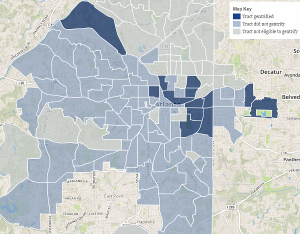 hat, Atlanta is segregated in certain parts with certain people.
hat, Atlanta is segregated in certain parts with certain people.
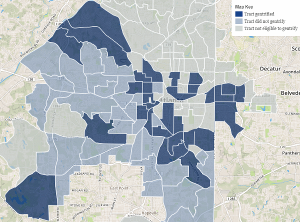
Here is a map that shows Atlanta’s division of people. While it may not be accurate with terms, it sure tells a story. Though we don’t always intentionally draw these lines, we help distinguish them by where we shop, where we eat, the places we go, and most importantly the places we don’t go. But of course, there is also a thing as “built environments”.
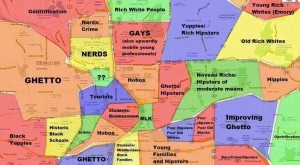
Architectures have a job and their job is to create and design functional buildings and places that serve whatever purpose is needed. Now, the question is: are some of the designs meant to keep people out: exclusion? That is the million dollar question. I would say yes. Through design, policies and requirements, this is what creates inclusion as well as exclusion. During my down time, when I can get away from my responsibilities and enjoy just a little bit of relaxation, I like to explore out into Atlanta’s attractions. Yes, I am a person who loves my relaxation. There is so much to do in Atlanta, I could go on new adventures every week, while I have ventured out, I have managed to see two brilliant locations, the Aquarium, the High Museum of Arts. These were beyond amazing and for myself quite refreshing. But one of my favorites by far has been the Chattahoochee Coffee Company. Such a serene and beautiful place off of the river, in a gated community, but still accessible to the public.
There is also one that I can only wish to enjoy due to my love for mini golf, The East Lake Golf Club. Why would that be? Well, But remember when I said, not every place is for everyone. This partially what I am referring to. You see, while many places welcome the public, or all people. Some places, like the Eastlake Golf Club, does not. Even though the East Lake Golf Club rests in the East Lake Neighborhood that in recent years, went through gentrification. During these times, Tom Cousins and a few of his supporters went through the East Lake Neighborhood and did a complete makeover. They tore down the apartment housings and replaced them with beautiful homes, brought more jobs, better education and child care to the area.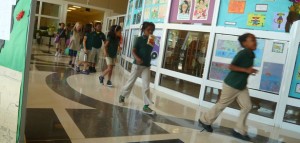
Many people can attest to the difference that this transformation had on their lives and living conditions. While some people were allowed to remain within their neighborhood, many were not. You see, this was a neighborhood of crime, usually referred to as “Little Vietnam”. Even police officers were afraid to take calls here. Between the drug infested streets and low poverty living. I recall reading the “The Big Discussion With Gentrification in Atlanta” article and I remember the interview that took place with Tom Cousins, and other investors who helped clean up the neighborhood. The mission was to bring about a change, completely transform the neighborhoods. This is exactly what they did and while they may have very well did everything that they did with GREAT intentions for us all, not everyone benefitted from this transformation. Many testimonies were given in regards to East Lake Neighborhood before and after the changes. One person in particular was Travon. He discussed his views on how gentrification erased the historical and sentimental meaning of the black culture in those neighborhoods, by mixing them or completely taking them over making them unrecognizable to what some used to call home. In regards to erasing the history built, the thing that was even more less fortunate was that lots of people weren’t able to return back to their homes after the neighborhood transformation. These new homes now had really strict guidelines as to who can stay in these homes, the kind of income they must have, drug tests of course, which I actually approve of, but overall this left many people homeless with no place to return. Imagine that.

East Lake Neighborhood is also home to the newly renovated and thriving Golf Club. The East lake Golf Club sits in the middle of the neighborhood now. When I first signed up to observe and do a built environment description the Golf Club I was very excited due to my love for golf. (I am no Tiger Woods, but I enjoy it like no other). Well, to my dismay, upon arrival to the golf course, I was met by a closed off gated community with a very strict gate attendant who not allow me to enter due to membership purposes and of course, I a person, who looks nothing like a golfer or anyone who would a membership through any major corporation was denied access. This took me by complete surprise, I was really liking forward to getting on the other side of that gate. But unfortunately, even though it sits in the heart of East Lake neighborhood, where right across the street is a spiraling down-hill playground full of people of color, this golf course was not for people like us. My first thought was, well why have it here? Here where we all can see it from the backyards of our homes, our children can witness from this trash filled, paint peeling playground and see the nicer things such as a PGA tour stop golf course and will probably never get the chance to enjoy it, as a child and possibly as an adult.

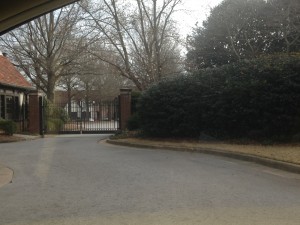

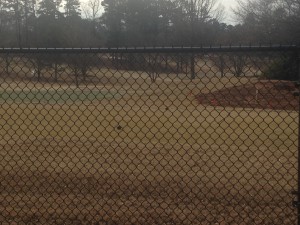
As I sat around, I teased myself by walking back and forth as I watched two upper class white men through the holes in the gate. They really seemed to be enjoying themselves on this particular Sunday morning, until I was caught staring. I felt embarrassed and further more as if I did not belong. I slowly backed away and sat in my car alongside the road to record everything that I had witnessed, the emotions I felt and everything that I could remember seeing through the gates before I made the golfers feel uncomfortable as well as I. all I can remember saying is “wow, this is beautiful and the grass is soo nurtured”. I knew that that place was a place for the elites and upper class people who could afford their membership through the positions they held. And I remember looking directly behind me, and seeing a park filled with African American children running and playing in a park that in comparison to the Golf Club was not fair, but it was all that they had.


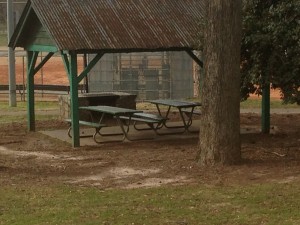
Being in the midst of the Golf Course was an experience all by itself. But I was so refreshed when it was time to choose another environment, the Chattahoochee Coffee Company. Now, I cannot say that I was not disappointed when I did my research and found out that I had yet selected another gated community. (Big sigh) but the fact that I, and people of all races, and social classes would be allowed regardless of anything demo-graphical about me was a great relief.
During my built environment observation time, I had the pleasure of observing the Chattahoochee Coffee Company, as I mentioned before. This was by far one of the greater and relaxing times I have had since living here in Atlanta. Chattahoochee Coffee Company is located off of Akers Mill Road in the Walton Community Apartments. The apartments themselves are beautiful and freshly renovated. It is a gated community that you must dial in to before you can access the Coffee House on the river. It was the most serene place to be. I have now made this my little relaxation spot that I like to revisit through the week. Due to it being closed to the public on the weekends, which I personally did not mind at all, their public hours through the week are sufficient enough: meaning they are open five days out of seven which is pretty impressive and for that I am grateful. I sat here for hours taking in the breeze in the morning and the sun in the later afternoon.
 As I sipped my peach mango smoothie, I observed my surroundings which was filled with a diversified group of people alongside the river. This made me feel very welcome. There was a family walking along the river with their newly walking baby, a couple of college students huddled together studying, an African American guy listening to music as he read a book, and etc. The coffee shop attendees were very pleasant and made sure that everyone was comfortable and received the best service you could have asked for. I was very pleased with the environment. I just would have never imagined something so serene, I would have access to.
As I sipped my peach mango smoothie, I observed my surroundings which was filled with a diversified group of people alongside the river. This made me feel very welcome. There was a family walking along the river with their newly walking baby, a couple of college students huddled together studying, an African American guy listening to music as he read a book, and etc. The coffee shop attendees were very pleasant and made sure that everyone was comfortable and received the best service you could have asked for. I was very pleased with the environment. I just would have never imagined something so serene, I would have access to.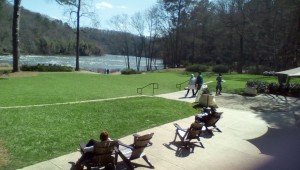
As you see, the Golf Club and the Chattahoochee Coffee Company were like night and day for me. While they are both great attractions, as well as many others in Atlanta, some of us aren’t lucky or privileged enough to experience them both or all.
Sources:
Max Blau. “Creative Loafing.” Can Anyone Stop Atlanta’s Gentrification. 13 Feb 2015. Web. 04 Feb 2016. http://clatl.com/freshloaf/archives/2015/02/03/can-anyone-stop-atlantas-rapid-gentrification.
“PBS Newshour.” Chasing the Dream: Poverty and Opportunity in America. PBS, 09 May 2015. Web. 22 Feb 2016. http://www.pbs.org/newshour/bb/can-u-s-break-clusters-poverty-roiling-south/.
Garland, Sarah . “The Atlantic .” Rich Kid, Poor Kid: How Mixed Neighborhoods Could Save America’s Schools. The Atlantic, 25 Jul 2012. Web. 28 Mar 2016. <http://www.theatlantic.com/national/archive/2012/07/rich-kid-poor-kid-how-mixed-neighborhoods-could-save-americas-schools/260308/>
“An Atlanta Neighborhood Tries To Redefine Gentrification.”Frontiers of Race, Culture and Ethnicity. Code Switch, 23 Sep 2015. Web. 04 Feb 2016. <http://www.npr.org/sections/codeswitch/2015/09/23/435293852/an-atlanta-neighborhood-tries-to-redefine-gentrification>.
 In this first picture, you can see the many different characters that stars in many of his shows and plays. This picture shows what it is all about about, the drama, the hurt, pain, hardships but also the glory and comedic relief that it provides to the audience.
In this first picture, you can see the many different characters that stars in many of his shows and plays. This picture shows what it is all about about, the drama, the hurt, pain, hardships but also the glory and comedic relief that it provides to the audience.
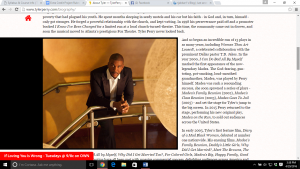 Here is an image of Tyler Perry alongside his biography of his life and all of his accomplishments. He tells the stories of how he became who he is despite who he was and encourages others that they too can do the same with the proper help with the lord above. He introduces himself and tells of where his inspiration came from. In this picture, he expresses a face of seriousness, instead of the humorous expressions he is known to have.
Here is an image of Tyler Perry alongside his biography of his life and all of his accomplishments. He tells the stories of how he became who he is despite who he was and encourages others that they too can do the same with the proper help with the lord above. He introduces himself and tells of where his inspiration came from. In this picture, he expresses a face of seriousness, instead of the humorous expressions he is known to have.
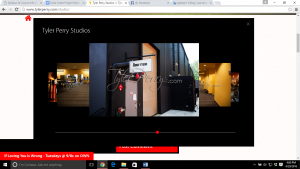 In this clip, there are images of his studio which was opened up in the year of 2008. On the website, it gives a tour of his Atlanta studio where he records his shows, it comprises of of five sound stages, a post production facility, a pond, a back lot, a 400-seat theater, a private screening room.
In this clip, there are images of his studio which was opened up in the year of 2008. On the website, it gives a tour of his Atlanta studio where he records his shows, it comprises of of five sound stages, a post production facility, a pond, a back lot, a 400-seat theater, a private screening room.
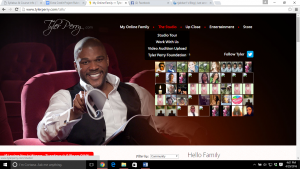 In this photo, he is pictured pointing with the paper at the screen, reading off “we want you, come join us!” He is looking directly into the camera, as if he is speaking to someone. His smile shows his passion. There are several links on the website that provides information on auditions and joining his cast. His website gives everyone a chance to audition and be apart of this christian based family who helps reach and change peoples lives.
In this photo, he is pictured pointing with the paper at the screen, reading off “we want you, come join us!” He is looking directly into the camera, as if he is speaking to someone. His smile shows his passion. There are several links on the website that provides information on auditions and joining his cast. His website gives everyone a chance to audition and be apart of this christian based family who helps reach and change peoples lives.  On this page, he states how he enjoys reading what the fans have to say, he loves their ideas for his shows and he takes inconsideration their input. He calls it his inspirational corner where he interacts with his fans and let them know that he will never forget about them and how he is the man he is because of their support.
On this page, he states how he enjoys reading what the fans have to say, he loves their ideas for his shows and he takes inconsideration their input. He calls it his inspirational corner where he interacts with his fans and let them know that he will never forget about them and how he is the man he is because of their support.
Tyler Perry has an open platform for Christian actors and his website is like a welcome to those who wants to come along and join his cast. He is the creator of many plays, his first one being “I Can Bad All By Myself”. He eventually branched out into films, with the character everyone knows so well “Madea”. His website showcases a sense of seriousness about sensitive topics but it also brings in the humor. The website is themed in darker colors, serious faces alongside cheerful ones which is an expression of the content that he brings to his shows.
The pictures that are posted on the website showcases his personality and interaction with his cast. Which in my opinion, allows future cast mates to see that is not all about work but about building a family of fun laughter and hard work and most importantly glorifying God despite their own troubles and the ones they create in characters.
I have been a fan of Tyler Perry for years now. When he first started his shows were centered on the black woman and their struggles, which created a platform for black women and an audience of the black community. Now you can find actors of all races in his films which I think is great. It started out a platform to reflect the trials in the black community within the black families and now it showcases that we all need Christ and we all can serve him together.
Perry opened up his studio in Atlanta which was previously the Delta Airlines campus. This is where he produces and films his shows as well as entertaining and hosting events.
His website features a biography that discusses where and how he grew up and where all of his inspiration comes from, from being homeless, poor and abused. It goes in to detail of his life story and how he became who he is and why he does what he does, providing home based humor in all of life’s circumstances. He has been an advocate and great supporter of the NAACP and has been giving back to all those who has helped him achieve his success this far.
Tyler Perry’s website is featured with many serious faces, yet delightful fun spirited characters as well.
The website gives off a classic vibe with him tailored in a nice suit, and colors of black and white, this to me shows that even though he is full comedy, he also has a business side that allows him to be serious and the true business man that he is.
Annotated Bibliography 1:
“An Atlanta Neighborhood Tries To Redefine Gentrification.”Frontiers of Race, Culture and Ethnicity. Code Switch, 23 Sep 2015. Web. 04 Feb 2016. <http://www.npr.org/sections/codeswitch/2015/09/23/435293852/an-atlanta-neighborhood-tries-to-redefine-gentrification>.
This article discusses how the east lake golf club that sits in a neighborhood that once was in the middle full of crime, poverty and public housing projects ,and a Golf course with dry patchy land where golfers risked the case of a stray bullet, but is now a PGA tour stop due to the redevelopment and Golf Club. The neighborhood was so full of trouble and crime that it was known as the war zone and nick named “Little Vietnam”. It discusses how the crime rate was 18 times the national average. The article talks about how the golf club helped reestablish the community by being a source of funds and support. Although the intentions of the reconstruction was to create mixed-income housing to go along with schools, child care and jobs of quality article discusses how the some people were forced out of the new found transformed neighborhood due to certain requirements.
I think this article is important because it gives insight from the residents who once belonged to that community before the gentrification. This article provides so much history on what East Lake neighborhoods were like and how deprived and forsaken they were. It provides information on how the changes began and the effects of those changes. Whether good or bad, it gave testimonies on how it affected those looking for a stable safe place to live and raise families and also those who were forced to remove themselves due to those new requirements.
Annotated Bibliography 2:
Deirdre A. Oakley. “ASA Footnotes: A Publication of American Sociological Association.” Annual Meeting Premieres The Atlanta Way: A Documentary on Gentrification. ASA, Jul 2010. Web. 2 Feb 2016. <http://www.asanet.org/footnotes/julyaugust10/am_0710.html>.
This article is a profound one.it talks about the first premiere of the documentary. It also discusses the contradictory effects of the gentrification of the Atlanta neighborhoods that has been taken place and causing the predominantly poor black neighborhoods more suitable for affluent white people who can afford the upgraded living areas. It had great details about the purpose of the film with several interviews including Professor Deirdre A. Oakley. She expressed her opinion with great knowledge of what has been taking place in Atlanta residence. She summarizes her views of how this is creating a less diverse environment and how one sided the benefits are for those who can afford to remain or move to Atlanta.
She gives details and information about the writer of the film, King Williams in an interview segment that wouldn’t likely be found anywhere else.it allowed him to tell his story and give us a view of what was in his mind when he created the film and what inspired him to do so.
This article is a great resource for capturing the highlights of the film and to get insight on what gentrification is and how homelessness and displacement occurred in our city. Through this site, there lies more information about gentrification and how it’s like a two sided coin and were only looking at the side that is turned up our way.
Annotated Bibliography 3:
Max Blau. “Creative Loafing.” Can Anyone Stop Atlanta’s Gentrification. 13 Feb 2015. Web. 04 Feb 2016. http://clatl.com/freshloaf/archives/2015/02/03/can-anyone-stop-atlantas-rapid-gentrification.
Can Anyone Stop Atlanta’s Gentrification is a detailed article that has maps describing and illustrating the gentrification process since the 1990s and now the most recent map of 2015. The maps are vivid, well researched and informative.
The article provides a lot of documentation on what has been happening nationally to gentrify our cities. The author states that gentrification is happening but it is also causing our neighborhoods to become more affluent driving out the previous residents that were predominantly black. The article begs the question of what is actually happening to those who previously resided in these project homes now turned lofts and condos. This also leaves us to the bigger question, is this really a good thing and if possible is there any way to stop the gentrification. This article has statements from Mayor Kasim Reed and other government officials and their views of the rapid gentrification.
This source provides helpful information on the gentrification and illustrations showing how Atlanta is gentrifying twice as fast than any other city in America. It also discusses census data for 50 of the nation’s largest cities, which was published by Governing This Month.


Annotated Bibliography #4
Bracey , Trayon . “The Big Discussion with Gentrification in Atlanta .” The Lifestyle Room . 20 Jan 2016. Web. 24 Feb 2016. <http://artrevmagazine.weebly.com/lifestyle/the-big-discussion-with-gentrification-in-atlanta.
The Big Discussion with Gentrification is a topic discussed with Travon Bracey published by The Atriv Magazine in the Lifestyle section. This article discusses His personal experiences of living in Atlanta and how gentrification has affected him and black culture as a whole in terms of socially, financially, politically, mentally and also educationally.
He discusses his experiences in the East Lake neighborhood as a child growing up, he reflects back on his memories of living in these neighborhoods and all the good memories he once shared there, with the people, the inspiring graffiti walled art,(what we may think is gang related), just everything in the environment that creates black culture. He discusses the differences in the community from then to now. He makes a lot of valid points in my opinon…
This article goes to show that even though Tom Cousins and other investors who helped clean up the neighborhood, bringing about a change, completely transforming the neighborhoods, may have very well did everything that they did with GREAT intentions for us all, but not everyone sees it that way and Travon is just one of those people who decided to speak on his views on how gentrification erased the historical and sentimental meaning of the black culture in those neighborhoods, by mixing them or completely taking them over making them unrecognizable to what some used to call home.
This article was an insightful, just to be able to read another side of a story of someone who views the former East Lake neighborhood as something more than a drug filled, crime raised, dead cop zone.
Annotated Bibliography #5
“PBS Newshour.” Chasing the Dream: Poverty and Opportunity in America. PBS, 09 May 2015. Web. 22 Feb 2016. http://www.pbs.org/newshour/bb/can-u-s-break-clusters-poverty-roiling-south/.

Chasing the Dream: Poverty and Opportunity in America is described as a multi-platform public media initiative that provides a deeper understanding of the impact of poverty on American society. This article, which I saw as the complete opposite of “The Big Discussion of Gentrification of Atlanta by Travon Bracey.
This platform allows Jimmy Williams, who after prison dedicated his life to improving poverty driven neighborhoods, to tell his story on how he was caught up dealing drugs in the East Lake community. He describes the toughness of the town and the difficulties to succeed and how he succumbed to the streets and dealing drugs, which landed him seven years in prison and also gave him what he needed to be who he is today, to be able to help those who was once in his position and to prevent others from being there.
This platform speaks of positivity about the transformation. Through research you’ll see that there are several sides to how gentrification has affected its people who live and have lived in these neighborhoods. This article just shows that everything that Tom Cousins and the foundation, Purpose Built Communities, set out to do to improve not just the neighborhood but the community surrounded by them, did in many ways have a great impact on many people.

Annotated Bibliography #6
Felton, Carly. “Atlanta Intown .” Transformation of East Lake.Springs Publishing LLC, 01 Aug 2009. Web. 20 Feb 2016. <http://www.atlantaintownpaper.com/2009/08/the-transformation-of-east-lake/>.
The Transformation at East Lake is an article published by Carly Felting, who discusses the stats that made East Lake neighborhoods such a poverty crazed and criminalized place to live in. it gives a great visual as to why, when and how to why Tom Cousins decided to embark on the journey to transforming East Lake Atlanta’s neighborhoods, these neighborhoods that were once filled with drug dealers and lords, Tom had a vision and though it is was quite risky, it was the greatest endeavor yet. This article would we great for research because it puts numbers into the equations for greater understanding as to how rough and tough these neighborhoods were before the transformation. There are also statements provided from those who were born and raised, or those who did the raising of their children there, stating that being born and subjected to this neighborhood, they never had a chance.
The article discusses the restoration of the golf course, building of new homes, and the transformation of the community, it is very detailed with numbers and it ends with stats showing the outcome of Tom Cousins attempt to making it greater, it shows in numbers the percentage of children and families who now have a chance.
Annotated Bibliography #7
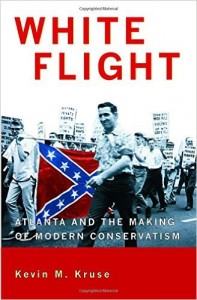
Kevin , Kruse. White Flight: Atlanta and the Making of Modern Conservatism. Princeton University Press, 2007. Print.
White Flight: Atlanta and the Making of Modern Conservatism is a book written by Kevin Kruse. It is described as “the study of white resistance to desegregation” This book discusses politics and society in the twentieth century America. You can find this book on amazon alongside several informative reviewer’s comments and excitement about this book. Although I did not read the entire book, I found the information regarding the book really insightful at the least. Through the reviews, I was able to see that the book is very easy to read and well written. This book will teach you about Atlanta and its history. It is said to be well researched and informative, and though some people may not be too fond of history and politics, Kevin Kruse did an excellent job on being able to keep your attention while revealing the truth and segregation, discrimination and white flight.
This is a review of Thomas J. Sugrue, Kahn Professor of History and Sociology, University of Pennsylvania, who is also the author of The Origins of the Urban Crisis. -“White Flight is a myth-shattering book. Focusing on the city that prided itself as ‘too busy to hate,’ Kevin Kruse reveals the everyday ways that middle-class whites in Atlanta resisted civil rights, withdrew from the public sphere, and in the process fashioned a new, grassroots, suburban-based conservatism. This important book has national implications for our thinking about the links between race, suburbanization, and the rise of the New Right.” Pretty awesome book right?
Annotated Bibliography #8
Cheney-Rice, Zak. “These Seven CIties Expose Exactly What Gentrification is Doing to America.” Identities.Mic. Mic, 2011. Web. 02 Apr 2016. <http://mic.com/articles/102004/these-7-cities-expose-exactly-what-gentrification-is-doing-to-america#.ve9STekQ6>.
This article was written by Zak Cheney-Rice, the Senior Staff writer of mic, on October 22, 2014, which was published on mic.com. I find this source to be extremely useful due to the format and layout of the site, and how easy it is to scroll through and see the numbers and percentages that are used to describe the problems and patterns of gentrification in the seven cities listed: Boston, Seattle, New York City, San Francisco, Washington D.C., Atlanta of course, and Chicago.
This site provides information that other websites may not have because it is not just based off of opinions, but facts and reality instead. While reading this article, I found myself being saddened at the reality of gentrification and how many have prospered and the expense of others and the loss of their homes and environments. Through reading, I found the article to very knowledgeable and insightful none the least. If you ever wanted to know what is going on the world, and not just Atlanta, this is the website that provides a heads up on the changes and transformations that has been happening in our very own town and others since the 1960s.
Annotated Bibliography #9

Garland, Sarah . “The Atlantic .” Rich Kid, Poor Kid: How Mixed Neighborhoods Could Save America’s Schools. The Atlantic, 25 Jul 2012. Web. 28 Mar 2016. <http://www.theatlantic.com/national/archive/2012/07/rich-kid-poor-kid-how-mixed-neighborhoods-could-save-americas-schools/260308/>.
Rich Kid, Poor Kid: How Mixed Neighborhoods Could Save America’s Schools is an article written in the online magazine: the Atlantic. It is written by Sarah Garland and was published on July 25, 2012. This article discusses the the question: “ In a former Atlanta slum, low- and middle-income families now live side by side — and send their children to the same excellent school. Is this surprising model too good to be true?”
This article discusses integration in a Charter school in East Lake Atlanta, Charles Drew Charter School. It gives the testimony of Theresa Cartwright and her experiences in the public school system during the “little Vietnam days” and how her mom transferred her and gave her a better opportunity and life while her fellow classmates traveled the road of public assistance. She goes to mention how over the years, the school system has changed and how she pulled her son from private school and enrolled him into Charles Drew Charter school that is much more integrated regardless of race and social class, which I think was a great idea.
This article goes to show how integration can produce great results for the children in our community. It gives them something to work towards and a better perspective of live when they can see better, they can then believe that they can achieve better.
This article was very educating and interesting. I love the personal testimonies because it gives insight on a real life event instead of opinions or projections of the integration turn out. I learned a lot about the school systems here in Atlanta and all that the transformation have down for our community instead of all the downfalls of gentrification.
Annotated Bibliography #10
Apperson, Jarod . “An Afterward to White Flight: Atlanta’s Return to Community & Long Road Toward Integration.” East Atlanta Patch . 10 Feb 2013. Web. 12 Apr 2016. <http://patch.com/georgia/eastatlanta/bp–an-afterward-to-white-flight-atlantas-return-to-cd126722ab4>.
“An Afterward to White Flight: Atlanta’s Return to Community & Long Road Toward Integration” is an article published on East Atlanta Patch. Was written by Jarod Apperson on February 10, 2013. It discusses Atlanta’s journey from the year of the 1970s to today. It discusses the forced integration that took place that led to many white people to withdraw from public life and ultimately the city altogether. The white population dropped from 300,000 to 122,000 between the 1960s and 1990s.
The article takes the time to discuss the “Black Mecca” which increased the black population. It also discusses the violence and crime that followed in the black community which caused for gentrification and integration that some was opposed to. This integration would allow everyone to come together and make the environment more diverse and create more opportunities for all. With the many attractions, school systems ,transforming neighborhoods, and many other things, it discusses how the white flight was reversed. If you ever would want to learn what white flight is, and the history of it and how it affected our Atlanta this would be a great starting place. Very informative article.
 hat, Atlanta is segregated in certain parts with certain people.
hat, Atlanta is segregated in certain parts with certain people.
 As I sipped my peach mango smoothie, I observed my surroundings which was filled with a diversified group of people alongside the river. This made me feel very welcome. There was a family walking along the river with their newly walking baby, a couple of college students huddled together studying, an African American guy listening to music as he read a book, and etc. The coffee shop attendees were very pleasant and made sure that everyone was comfortable and received the best service you could have asked for. I was very pleased with the environment. I just would have never imagined something so serene, I would have access to.
As I sipped my peach mango smoothie, I observed my surroundings which was filled with a diversified group of people alongside the river. This made me feel very welcome. There was a family walking along the river with their newly walking baby, a couple of college students huddled together studying, an African American guy listening to music as he read a book, and etc. The coffee shop attendees were very pleasant and made sure that everyone was comfortable and received the best service you could have asked for. I was very pleased with the environment. I just would have never imagined something so serene, I would have access to.










 In this first picture, you can see the many different characters that stars in many of his shows and plays. This picture shows what it is all about about, the drama, the hurt, pain, hardships but also the glory and comedic relief that it provides to the audience.
In this first picture, you can see the many different characters that stars in many of his shows and plays. This picture shows what it is all about about, the drama, the hurt, pain, hardships but also the glory and comedic relief that it provides to the audience.



